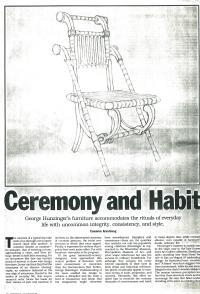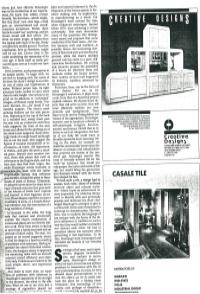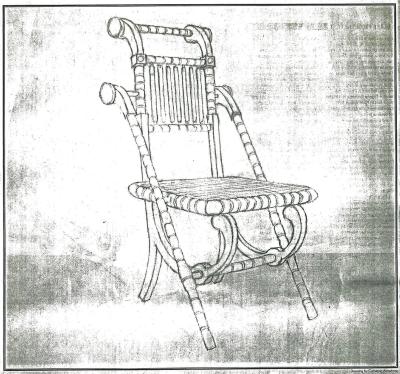go to... Metropolis
Ceremony and Habit
By Cameron Armstrong
Metropolis, October 1985


Cameron's 1985 Metropolis essay about George Hunzinger's furniture design expands from a detailed analysis of one chair to discuss what makes furniture furniture - and what Hunzinger's work can teach about attention and convention, and the balance to be struck between meaning, visibility and function.

The routines of a typical day move us through one unexamined, unquestioned ritual after another. A few moments taken at random - the sequence of entering a room, perhaps, approaching a chair, and then sitting - seems unburdened by deep meaning. Yet commonplaces like these contain much of compelling interest for the chair's designer. Such banalities trace the outlines of an obscure choreography, a fundamental order balanced at the very edge of awareness. Rooted in everyday habits, its obscure relations offer much to guide style's evolution, in all its cultural and commercial aspects. In the abbreviated ceremony of such common gestures, we can see the proprieties and conventions - social, political and cultural - to which for economic and other reasons the designer must appeal. Under this paradoxical regime, invention and inventor can thrive only in obscure recesses at the corner of the mind's eye.
There, in the dimmed attention of the unprovoked mind, creation can mix with normality by maintaining domesticity's unrippled calm. No designer forgets that with furniture, normality is the program.
Of the great nineteenth century designers, none approached this central conundrum with more wit and conviction than the German-born New Yorker, George Hunzinger. Understanding it enabled him to achieve a disciplined clarity of vision and formal consistency that his imagination might otherwise have overwhelmed. Discipline and consistency - these are the qualities that underlie not only his popularity among collectors but his success in ordinary households. For although in details and allusion they surpass even the rich eclecticism of their time, his pieces constantly appeal to timeless conventions of size, proportion and material. Hunzinger's hard won reconciliation of fresh awareness with deadening habit - in piece after piece, decade after decade - reflects both a deft ability to synthesize technique and history, and the enormous demands placed upon the designer by changes in social and industrial organization.
Hunzinger's mastery is readily seen in a particular chair recently on
display in Yale University's Garvan Collection. Small and dark - standing
less than three feet high - it has an elegant (if misleading) design.
Horizontal bars, roundels, and an overall A-frame structure suggest rotation
or movement, while its light seat seems hinged to an open wooden skeleton.
The tension between perception and fact created by this easy (but false)
impression of folding is only the first of Hunzinger's skillful moves
in manipulating expectations. He knew that by subtly underlining his submission
to the convention's boundaries, he could gain an unconstrained acceptance
for otherwise somewhat strange objects - even for chairs which, like this
one, don't even have proper legs. By emphasizing these limits he was freed
to "say practically anything," and his chairs would still find
sitters. The Garvan chair - no wider, longer, or higher than the typical
side chair of its era - firmly claims this middle ground.
Even with 20th Century eyes, our first impression might well be our last. Except that in this particular case, such unthinking presumption is not so easily secured. First, in keeping with the tastes of its time the design is loudly comprised of an eclectic mix of styles, both realized and suggested. And lacking proper legs, its light frame looks barely able to carry its own weight, much less the rotund proportions of a Gilded Age purchaser. Depending upon allusions to archetypal furniture - to Roman camp stools, Teutonic thrones, Assyrian benches, etc. - for a measure of visual strength seems even more to emphasize its structural limits. The chair's most striking features are side pieces which, beginning with rounded ends at the top of the backrest, sweep down past the seat into an exuberant swirl supporting the seat front, and allowing for the rear supports (not legs) to be grafted on. Each one (deceptively) suggesting construction from a single board, they suggest the figures of musical composition or instruments - of notes, clefs, or violins - and give the piece a harmonic grace. Beyond this emotive content, these side pieces also embody aspects of the fashionable Empire Style. But while Hunzinger was certainly moved by economic reasons to make this association, the references clearly intend a much deeper reach into history. His allusive curves draw the chair into a formal evolution from the volutes of the Greeks' Ionic order and beyond, to their Egyptian ancestors. These shapes represent not just a musicality of sorts, or a simple historical (and political) reference, but a summation of long traditions of artistic work.
In contrast to the sides, the long rods that structurally sustain the chair's
plethora of curves, planes and metaphors seem not directly allusive at all.
Their grooved, machine-turned shapes seem to spring directly from functional
needs, in an attitude of bland utility. The seat too, poised at the very tips
of the curved side pieces' lyrical climax, seems shaped by a head-on meeting
of problems with solutions. Having elsewhere orchestrated a fulsome repertoire
of historical allusions, the designer seems to approach remaining tasks as
matters purely of efficiency.
But there's more than a simple equation of problems and solutions in Hunzinger's
oppositions of straight to sinuous, silent to allusive. And it's certainly
not only a game of visual oppositions, played out on a narrow field of
stylistic possibilities. On one hand, the curving shapes of the sides
suggest a construction dependent on the solitary work of a skilled, dedicated
craftsman. On the other, the frame's rhythm of turned grooves and efficient
(though at times awkward) connections implies the impersonal rigors of
mass production. Together, these shadows of the object's manufacture show
the designer wrestling with ideas about labor, productivity and material
implicit in the factory system's growth. For Hunzinger worked during a
time of constant, sometimes dire confrontation between man and machine,
when industrial techniques achieved a painful dominance over centuries-old
ways of organizing work and social life. This chair documents that crisis,
and proposes a resolution. Hence the interacting rhetorics of historical
style and mechanical process: while the chair's multiply grooved rods
lay claim to a pure functionalism, the curving side elements suggest a
viability for inherited methods within the factory system. Hunzinger's
design presents a compelling vision of craft supported by industry, traditions
advanced by economics.
Humble as it is, this chair - emblematic of a vast constituency of mass
produced objects - demonstrates how a simple, usually unnoticed element
of domestic life can crystallize a broad network of desires. For its contemporaries,
it dreamed a life as functional tool, stylistic and political referent,
and theatrical prop. For Hunzinger, it was a chance to integrate signifiers
of function and culture into a means by which banal habits could enact
a fulfilment of history. This chair doesn't merely tell a story, it recruits
its sitters into a ceremonial narration of their era's primal drama, society's
industrial transformation and the alliances among artisans, workers, intellectuals
and industrialists that brought it about. Hunzinger would clearly have
welcomed such criticality - narratives like this were after all his creative
wellspring - as he brought his audience into thematic contact with the
forces that shaped its fate.
Striving
to find uses, meet expectations, disguise inconsistencies and conform
to stereotypes, the Garvan chair is a comprehensive vision of conflicts,
resolved. Wood, iron, machines, craftsmen, assembly line workers, designers,
capitalists and customers are all accommodated in the balanced synthesis
represented in the object. But let no one forget the pitiless regime under
which Hunzinger labored: one false move, one step too far from convention
and his chair would be unsittable - too strong a signifier for comfortable,
thoughtless repose. Ultimately it was its camouflage of normality that
made participation in normal life possible, despite its burden of uncomfortable
truths. It's even arguable that Hunzinger's long commercial success must
have been based at least in part on this ability to sublimate big crises
into placid household objects. Their plethora of signifiers made them
too complex for quick readings or easy apprehension, even as their conventional
proportions, materials and allusions cloaked the designer's radical mission.
Balanced at the edge of awareness, its narrative hidden in plain sight,
the Garvan chair is a triumphant elevation of common habits to the heights
of ceremony.